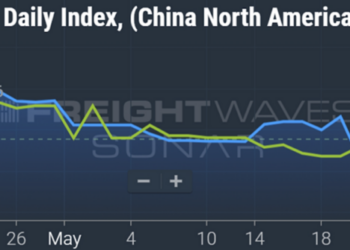Freight volume has been weak this month
Tender volume, which counts how often shippers request that carriers pick up loads, has shown weakness this month. (Chart: SONAR)
The Outbound Tender Volume Index (OTVI – above) is the SONAR chart that stands out the most to me this week. It measures the volume of requests from shippers to move loads. It moved 3.8% lower in the past two weeks and is 6.9% below the year-ago level. That 3.8% two-week decline breaks down to a 3.1% decline for the dry van segment and a 6.4% decline for reefer.
The tender volume decline brings up two questions: Is it driven by something more than seasonality? And, does that throw off the thesis that the freight market is poised to tighten later this year? Those questions were asked and answered in last week’s State of Freight Webinar. The conclusions: It may be partially driven by uncertainty related to the swift actions by the federal government, and no, respectively. February is typically the weakest month for freight, which makes it hard to draw any major conclusions. But March will be more telling, as it’s typically a strong month when shippers begin positioning summer merchandise.
The tender rejection rate is lower month over month but higher year over year. (Chart: SONAR)
The good news for carriers is that the Outbound Tender Reject Index, a measure of relative tightness in truckload capacity, remains above year-ago levels despite the weak tender volume. The implication is that a meaningful amount of capacity has exited the market, which sets the industry up for tightness during the stronger seasonal months. The current tender rejection rate of 5.3% is down from a year-to-date peak of 8.3%. That decline may have happened in January without the winter storms that temporarily removed some capacity from the market. Highlighting differences between equipment types, the current dry van and reefer tender rejection rates are 5% and 10.4%, respectively.
The trend in spot rates suggests that February has been normal seasonally. (Chart: SONAR)
The SONAR National Truckload Index, an aggregate of spot rates with the impact of fuel removed, shows a decline in spot rates that is very consistent with the pattern of the past two years. Similar to OTVI, whether spot rates bounce this spring will be telling.
Suggesting the freight market is improving, the spread between contract rates and spot rates has narrowed to within a range consistent with a relatively balanced freight market. (Chart: SONAR)
Ocean spot rates fall in China-to-US lanes
(Chart: SONAR)
In the past week, the Freightos Baltic Daily Index of spot rates declined 28% and 24% from China to the U.S. East Coast and U.S. West Coast, respectively. Rates in those lanes are still above where they were at the start of the Red Sea attacks (near the end of 2023) but are close to a 52-week low.
On Thursday, a Flexport newsletter added context to the sharp one-week change. Capacity is coming into the market in China-to-U.S. trade lanes following Chinese New Year. Capacity currently is over 90% of pre-Chinese New Year levels. Meanwhile, demand is also recovering but more slowly. That has left ample capacity available on vessels and without any major logistical bottlenecks. Flexport sees spot rates decreasing into March and does not expect a general rate increase next month.
The Stockout Show: Uncertainty, seasonality drive softening freight volume
(Image: FWTV)
On Monday’s The Stockout show, Grace Sharkey and I discussed the disappointing freight volume in February and why that doesn’t upend the potential for a tightening in the freight market later this year. In addition, we went through recent FreightWaves articles on how deportations may impact food supply chains and Amazon’s potential entry into the for-hire less-than-truckload market. Plus, Sharkey highlighted the themes from this year’s Manifest conference, including topics that were conspicuously absent. Watch Monday’s show here and check out the full The Stockout playlist here.
The post Are low February freight volumes more than seasonality? appeared first on FreightWaves.














